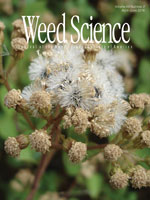A field study was undertaken to investigate the influence of different management strategies on rigid ryegrass plant density and seedbank dynamics over 4 yr. Even though weed seedbank declined by 86% after oaten hay in year 1, the residual seedbank enabled rigid ryegrass to reinfest field peas the next year, and the population rebounded sharply when weed control relied solely on PPI trifluralin. However, use of POST clethodim followed by crop-topping for seed-set prevention of rigid ryegrass in field pea was highly effective and caused a further decline in the weed seedbank. Integration of effective management tactics over 3 yr significantly reduced rigid ryegrass weed and spike density (90 and 81%) in the final year of the 4-yr cropping sequence. Use of oaten hay in year 1, followed by effective weed control in field pea and wheat crops, depleted the high initial seedbank (4,820 seeds m−2) to moderate levels (< 200 seeds m−2) within 3 yr. Effective weed-management treatments depleted the rigid ryegrass seedbank, reduced in-crop weed infestation, and returned higher grain yields and profitability. The results of this study clearly show that large rigid ryegrass populations can be managed effectively without reducing crop productivity and profitability provided multiyear weed-management programs are implemented effectively.
Nomenclature: Clethodim, trifluralin, rigid ryegrass, Lolium rigidum Gaudin LOLRI, field pea, Pisum sativum L, oat, Avena sativa L.; wheat; Triticum aestivum L.





